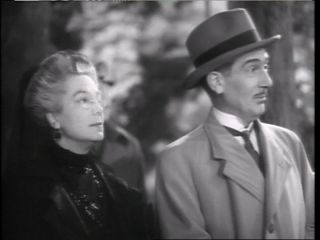The MacGuffin: News and Comment (02/Feb/2008)
(c) Ken Mogg (2008)
February 2
There's an excellent online appreciation by film historian Geoffrey O'Brien of The Lady Vanishes (1938) reproduced from the notes accompanying the new Criterion DVD release of Hitchcock's film ("All Aboard!" by Geoffrey O'Brien). For a start, I like O'Brien's observation that the film resembles 'the perfect matrix for the kind of paranoid melodrama that would proliferate ... in the forties (in films like Phantom Lady, Gaslight, and My Name Is Julia Ross), [only] here the dark shadows of conspiracy are countered by a brightness and brilliance of tone almost Mozartean in its equanimity'. More on that idea in a moment. O'Brien's sharp eye also spots how a scene early in the film, at the inn, comes straight from Top Hat (1935) - as I remember noting myself in 'The Alfred Hitchcock Story'. So was Hitchcock imagining his film as a kind of musical-on-wheels? Music certainly plays an important role in the film (as Michel Chion, Jack Sullivan, and others, have shown). We can talk about that idea, too, in a moment. But here's something else that O'Brien and I undoubtedly agree about. '[The] insistence [of the heroine Iris Henderson] on the reality of what she has seen', writes O'Brien, 'is the only sure guide through a labyrinth of false impressions, even as the insidious Dr. Hartz tries to convince her that the vanished Miss Froy is "merely a vivid subjective image."' Yes! (In the novel, Iris says to the engineer Max - the musician Gilbert in the film - 'Oh, can't you understand? If I didn't [find Miss Froy], I could never feel that anything, or anyone, was real again?' Incidentally, the novel, by Ethel Lina White, also contains the business of Miss Froy's name written on the train window which provides the first proof that the old lady has indeed been on board. It anticipates the writing on the piece of paper found in the toilet-bowl in Psycho, a concrete reminder that Marion has indeed been at the Bates Motel.) Of course, when Hartz is confronted with the apparent return of Miss Froy, he sounds like a peeved academic whose pet-theory has been attacked (the novel includes among its characters a rather supercilious professor): 'My theory was a perfectly good one, the facts were misleading', he says. More to the point, the film fits with the several others by Hitchcock, some of which we've noticed here recently, where incidents seem almost ghostly or phantasmagoric for a while. The baggage-car scene in TLV (with Doppo the Illusionist), the McKittrick Hotel scene in Vertigo (another 'vanishing lady' scene), and the Mrs-Bates-at-the-window shots in Psycho, are all deliberate teases by Hitchcock designed to to throw us off the scent - or to put us on a false scent. Even more to the point, TLV looks forward to Hitchcock's greatest train thriller, North by Northwest, for both are about 'getting real'. In 'The Alfred Hitchcock Story' I show how the NxNW titles sequence evokes a passage in T.S. Eliot's 'The Waste Land' (1922) - a work hugely influential among British intellectuals of the 1920s - whose 'Unreal City' is inhabited by death and ghosts. But at the end of the film, we hear the villain Vandamm (a descendent of Hartz) complain, 'That wasn't very sporting of you, using real bullets!' By contrast, in TLV, after Iris and Gilbert and Miss Froy have escaped from Hartz and his gang, he gazes after them from the pine forest (predecesor of the one in NxNW), and says sportingly, 'Jolly good luck to them!' (See frame-capture below.) For deliberate ironic effect, Hitchcock, almost on the eve of World War II, was evoking a nobler era dating back to Kipling and early John Buchan, when wars and spies were still part of what the British called 'the Great Game' - an extension of the playing-fields of Eton and Harrow and the cricket-fields of Lords and The Oval! Whereas, set at the height of the Cold War, NxNW is very much about 'realpolitic' - even as, like TLV,it sees in the romance of hero and heroine the sternest and noblest test of all. I'll go into more detail next time and talk about trains (and music) as a metaphor for cinema (and life). But let's not overlook for now how very astute and even prescient Ethel Lina White's 1936 novel (originally called 'The Wheel Spins') is. Geoffrey O'Brien calls it 'a rather unthrilling thriller', which is misleading. It intrigues by the very details that Hitchcock would borrow to use in TLV and subsequent films. It even calls Miss Froy at one point 'the phantom lady' while having Iris say, as she admits she's dreading going home to her circle of friends, 'There's not one real person among the lot of us ...'. What it doesn't have are Charters and Caldicott or a baggage-car scene ...
This material is copyright of Ken Mogg and the Hitchcock Scholars/'MacGuffin' website (home page) and is archived with the permission of the copyright holder. |

